When hundreds of burrowing gopher tortoises made their home in Orlando Sanford International’s runway safety area grass, the unassuming reptiles created a glaring problem for airport operational safety.
The solution? Replace the natural grass with artificial turf.
Gopher tortoises burrowing in close proximity to runways are a safety hazard to airport operations. And because the tortoises are a threatened species, relocating the animals and closing the burrows was a regulated process, as well as extremely time-consuming and costly for the airport. Between 2008 and 2014, the airport excavated over 875 burrows and removed 345 tortoises, costing nearly $400,000. And once removed, the tortoises typically came back to re-burrow.
The airport entered into an agreement with the FAA Airport Technology Research and Development Branch to conduct and fund the study, which was to measure the effectiveness of aviation turf to mitigate the presence of the burrowing tortoises.
The turtles were carefully removed and the area excavated. The artificial turf system was installed on a plot around the runway’s blast pad and infilled with sand ballast. Four wildlife cameras ran continuously along the perimeter of artificial turf, which recorded photographs of any movement.
After a year of observation and data collection, no tortoise burrowing was detected in the test area. The FAA study "Artificial Turf And Gopher Tortoises At Orlando Sanford International Airport," concluded that installing artificial turf in runway and taxiway safety areas can be an effective solution for wildlife control.
Wildlife management and federal regulations
Under federal regulations, airports are required to maintain runway safety areas free of hazardous ruts, humps, or other surface variations. In fact, a number of other airports in the FAA Southern Region have difficulty meeting the regulations due to holes caused by burrowing of gopher tortoises. Gopher tortoises are listed as a threatened species in Florida, and mitigation efforts are heavily regulated, expensive and time-consuming.
“Artificial turf can be used as part of long-term preventative wildlife control strategies, rather than reactive measures to capture and relocate,” said Daniel McSwain, general manager of AvTurf.
Aside from tortoises, encounters with wildlife, particularly birds, are a major concern in both the civil aviation and military environments around the world. Globally, wildlife strikes have killed more than 255 people and destroyed over 243 aircraft. This is due to the increase in bird population and the increase in aircraft, especially the quieter, turbofan-powered aircraft. Strikes increased from 1,851 in 1990 to 11,315 in 2013 with birds involved in 97 percent of those reported. Strikes have decreased over recent time due to wildlife management techniques and practices such as alternative habitat strategies which reduce attraction to airports. One of these techniques is the use of artificial turf.
Approximately 60 percent of bird strike encounters occur during landing, thus efforts have been directed to ensure wildlife control on the airfield. Synthetic aviation turf provides a non-lethal solution to mitigate wildlife and reduce the potential for bird strikes by removing food, water, or shelter near the runways. Eliminating mowing operations also significantly reduces the presence of specific birds such as cattle egrets, which accumulate in large numbers during such operations.
Artificial turf safety solution
In addition to wildlife and bird strike management, installing artificial turf can also help curb critical airfield safety issues such as foreign object debris (FOD), erosion and more, while providing a clean, green, and low maintenance surface area.
FOD damage is responsible for millions of dollars in damage to aircraft every year. Installing artificial turf on infield islands creates a sterile, static environment, with a consistent and low turf height to help airport operators easily identify and remove FOD. In addition, when areas normally subjected to jet blast are stabilized with a synthetic turf installation, the potential for pavement disaggregation and debris created by erosion is eliminated.
Artificial turf was installed at Detroit Metro Wayne County International Airport (DTW), to address issues of FOD due to jet blast. Static aircraft would power up to transition onto Runway 4R/22L for takeoff and the resulting jet blast propelled FOD onto the runway. This presented a potential safety risk for following aircraft taking off or landing, and created delays and lost revenue due to runway closures to remove the debris. While topsoil and hydro seed proved to be a very short-term resolution, since having the artificial turf installed, there has been no FOD blown on to the runway.
Visual Recognition
Differentiation between taxiway and runway pavements can be a challenge for pilots, and confusion on the flight deck can result when extra wide taxiways appear to be runway width. During low visibility conditions, in rain and fog, or when the sun is low on the horizon, marking can become virtually invisible. Configurations of northwest/southeast runways and taxiways are especially conducive to these conditions and exacerbated by the glare that pilots encounter on approach to landing.
Synthetic turf’s ability to enhance conspicuity and emphasize the differentiation of runway and taxiway pavement is outlined in "Identification Techniques to Reduce Confusion Between Taxiways and Adjacent Runways." In the study, four visual aid enhancements were tested at Seattle-Tacoma International Airport (SEA) and Palm Beach International Airport (PBI): an elevated lighted X, artificial turf, omnidirectional runway end identifier lights and an in-pavement lighted X. Each piece of equipment was placed on the taxiway and was evaluated while making final approaches to the runway. Based on the results, artificial turf was visually recognizable at 5 nautical miles, which is greater than any of the other options identified to assist as visual aids and markings.
Drainage
Laboratory and field drainage tests have been performed with successful results on artificial turf. The artificial turf system allows water to drain through natural percolation and the infill provides a natural filter that can drain up to 60 gallons of water per square foot per hour.
Chicago O’Hare International Airport (ORD) was one of the first airports to consider artificial turf to address drainage issues, as well as erosion and visual delineation problems. Water runoff from heavy rain and melting snow tended to pool around a waterway drain and saturate the soil. Previously, the airport had tried filling the area with concrete between the taxiway and runway, but water continued to pool at the drain without a mechanism to slow the water flow. It was also noted that the concrete diminished the visual distinction between the runway and taxiway.
The airport installed a single-strip turf area on the island between ORD’s Taxiways D6 and D7 reaching from the top of the island to the drain. This synthetic turf replaced the majority of the existing eroded and rutted grass, and ORD airport staff noted that it immediately slowed the flow of water, similar to natural grass. Airport maintenance workers stated that there have been no problems with any type of erosion or water pooling at this location and it provided better visual conspicuity over the commonly used method of painting the concrete surface.
Artificial turf helps stabilize runway and taxiway shoulders and prevents the erosion of soil abutting pavement because of jet blast and water run-off. A durable synthetic turf system also provides a surface that will support inadvertent excursions by aircraft and minimize damage to aircraft gear systems.
Installing artificial turf on airport property minimizes the need for equipment or personnel to be in or around runway and taxiway safety areas. Synthetic turf also aids vehicle operators and pilots to maintain situational awareness while moving on the airport surface.
ARFF Response
Both a Boeing 757 and multiple ARFF emergency service vehicles have traversed artificial turf installations with no signs of displacement or damage. Studies show artificial aviation turf performs well under a variety of environmental conditions. When exposed to jet blast, UV, wind and rain, the turf did not exhibit indications of deterioration and proved resilient to the passage of operational vehicles. Under both wet and dry conditions, the artificial turf did not exhibit detrimental reduced braking during aircraft or vehicle excursions. In addition to the burrowing tortoises, the Orlando Sanford study included high speed braking under wet and dry conditions. The artificial turf did not display any rutting and showed excellent braking conditions.
Design and Testing Standards
Improving runway safety is a continual effort for those involved in airside operations. In fact, runway safety is identified as a priority safety issue in the ICAO Safety Report 2015, with runway excursions as one of the top concerns.
The FAA has undertaken several other studies on the use of artificial turf in airport environments, which have produced effective results. According to FAA Advisory Circular 150/5370-15B, artificial turf is identified for “use in areas adjacent to certain airfield pavements as an alternate to natural turf or other surface treatments used to stabilize shoulders and safety areas” and “to mitigate localized erosion problems caused by jet blast, storm water runoff and surface damage caused by vehicles.”
Airside artificial turf systems shall meet a set of criteria and design standards as outlined by the FAA and successfully tested prior to the installation. Tests for jet blast, load bearing capacity, drainage characteristics, skid resistance, flammability, durability and more are all confirmed by third-party reports. Further verification of construction characteristics, such as weight, turf height, turf density, fiber thickness and breaking strength, are carried out via ASTM testing standards.
“After installing artificial turf at airports around the world with the first installation occurring over 15 years ago, it is clear that this is a long term solution to eliminate many of the operational issues that plague airports on a daily basis,” McSwain, said.
Several installation methods can be employed, depending on application, environment, size of installation and its intended use. Glue-down turf applications allow airports to replace painted areas of taxiways or small islands, typically for visual delineation purposes. The artificial turf helps identify non-movement areas and the color won’t fade like paint on concrete. Larger synthetic turf applications, such as along the sides of runways, will utilize a prepared base and milling of pavement edge or the installation of a header.
Daniel McSwain is general manager of Act Global AvTurf Inc. McSwain has almost 20 years of experience in the aviation industry with 12 of those years being spent in the development, testing, and now implementation of artificial turf on airfields around the world.



